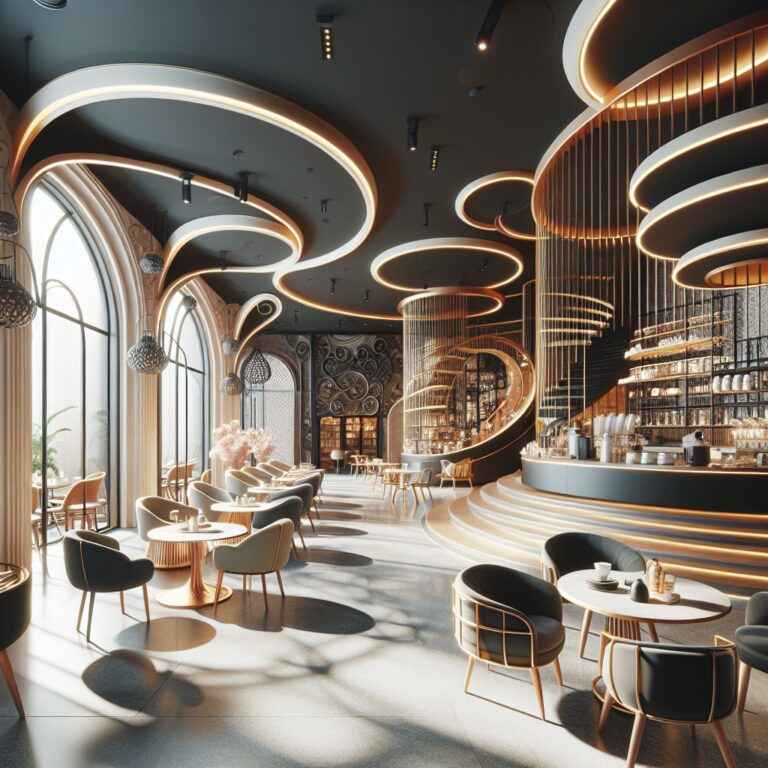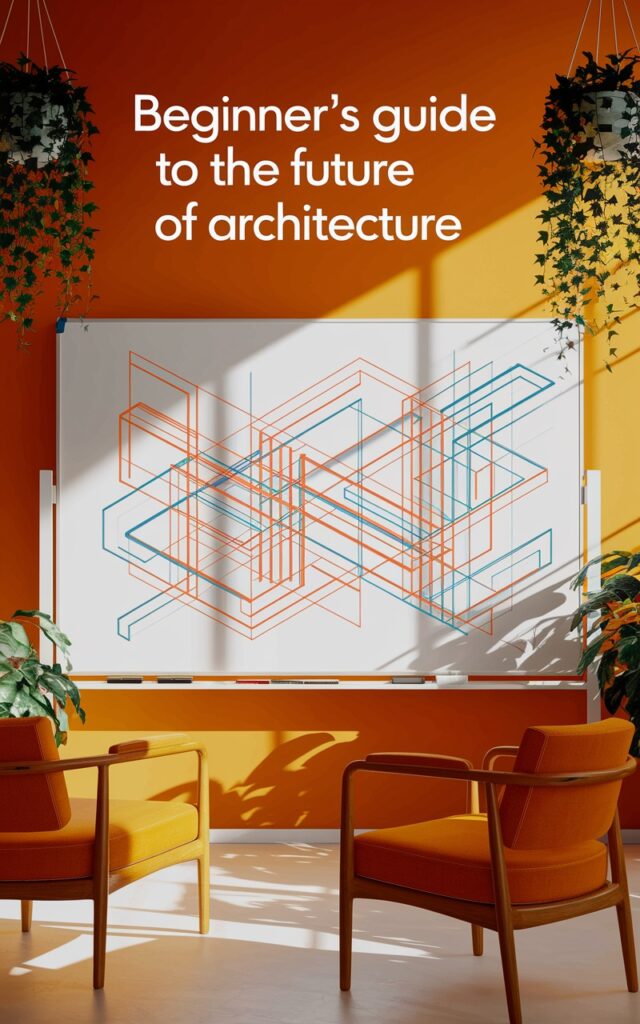Have you ever noticed how certain cafés draw you in and keep you lingering long after your coffee has gone cold? There’s more to that cozy feeling than just good lighting and comfy chairs.
*Behind every Instagram-worthy café space lies a carefully orchestrated dance of curves and contours that speaks directly to our subconscious.*
When you sink into that perfectly positioned armchair or lean against a thoughtfully curved counter, you’re experiencing parametric design at work—an advanced approach that uses mathematical relationships to create spaces that feel innately pleasing to the human experience. These subtle design elements aren’t random aesthetic choices but deliberate architectural decisions that connect with our evolutionary preferences for certain shapes and spaces. That feeling of “just right” isn’t accidental—it’s by design.*Where function meets feeling: The invisible dance of design that transforms ordinary spaces into extraordinary experiences*
Have you ever stepped into a café and immediately felt at ease, perhaps without knowing exactly why? That sensation of instant comfort, the inexplicable urge to linger, to breathe deeper, to settle in—it’s no accident. The spaces we love most speak to us in a language beyond words, communicated through curves, light, and flow that our bodies understand instinctively. That favorite café of yours, the one with the perfect ambiance? It’s quietly orchestrating an experience through intentional design elements that work together to create something greater than the sum of their parts.
The Psychology of Curves: Why We’re Drawn to Flowing Spaces
Walk into any wildly popular café and look up. Chances are, you’ll find yourself beneath a ceiling that doesn’t just exist—it performs. Parametric ceiling and lighting design transforms flat, utilitarian surfaces into dynamic elements that guide our experience of space. Unlike the harsh angles and flat surfaces that dominated commercial architecture for decades, these fluid, organic forms speak to something primordial in our perception.
Research in environmental psychology shows that humans have an innate preference for curved elements over sharp angles. Our brains process curved forms more easily, triggering positive emotional responses and reduced activity in areas associated with fear and anxiety. This is why the gentle wave of a custom ceiling installation or the perfect arc of a counter can make us feel welcome without saying a word.
From Nature to Nurture: Biomimicry in Design
These curved elements aren’t simply aesthetic choices—they’re often inspired by patterns found in nature, a design approach called biomimicry. Natural environments rarely feature perfect straight lines or right angles. Instead, they flow with organic precision, creating spaces that feel simultaneously ordered and free.
When commercial interiors incorporate these natural principles, they tap into our evolutionary comfort with organic environments. The rippling ceiling at your favorite gathering spot might be subtly reminiscent of waves or clouds, creating a subconscious connection to natural phenomena that humans have found pleasing for thousands of years.
Parametric Design: Mathematics Made Beautiful
Behind many of today’s most captivating commercial spaces lies a powerful design methodology known as parametric design. This approach uses computational algorithms to generate complex geometric forms that would be nearly impossible to conceive through traditional means.
Parametric design allows architects and designers to create forms that respond to specific variables—like how people move through a space, where natural light enters, or acoustic requirements. The result is aesthetic architecture made functional, where every curve serves a purpose beyond visual appeal.
From Algorithms to Atmosphere
In practice, parametric design translates mathematical relationships into physical experiences. That undulating ceiling feature that draws your eye when you enter isn’t just there to look interesting—it might be:
- Optimizing the acoustics to allow conversation without overwhelming noise
- Directing your gaze toward different functional areas of the space
- Creating zones of intimacy within an open floor plan
- Housing integrated lighting systems that enhance the space’s mood
- Improving air circulation and thermal comfort
The genius of well-executed parametric elements is that you experience their benefits without necessarily registering their presence consciously. They create what designers call “atmospheric performance”—where the technical aspects of a space directly contribute to its emotional impact.
Crafting Movement: How Design Choreographs Your Experience
Beyond the visual impact of curves and forms, great commercial spaces are designed with human movement in mind. Flow and circulation determine how we navigate environments, where we pause, and how we interact with others within the space.
Think about your last visit to a truly exceptional café. Did you notice how you instinctively knew where to order, where to wait, where to sit? This intuitive navigation doesn’t happen by accident—it’s the result of carefully choreographed design decisions.
The Invisible Dance of Space Planning
Effective commercial interiors use a combination of visual cues, physical elements, and spatial relationships to guide movement in ways that feel natural rather than forced. Curved paths, strategic lighting pools, and subtle floor pattern changes all serve as wayfinding elements that direct traffic without explicit signage.
The counter that curves just so, inviting you to approach from one direction. The slight elevation change that subtly defines a transition between ordering and seating areas. The ceiling feature that draws your eye toward the specialty coffee display. These elements work together to create a space that feels intuitive to navigate, reducing decision fatigue and enhancing the overall experience.
Creating Moments: Design That Delights the Senses
Beyond the functional aspects of guiding movement and defining space, thoughtfully designed commercial environments craft a customer experience through form that engages multiple senses. These sensory moments create emotional connections that transform a simple coffee run into a meaningful experience.
Multisensory Magic
When parametric elements and curved forms are integrated into a holistic design approach, they contribute to a rich sensory environment:
- Visual delight through changing perspectives as you move through the space
- Tactile experiences via materials that invite touch
- Acoustic comfort through sound-absorbing forms that manage noise levels
- Thermal comfort via airflow management
- Olfactory zoning that allows aromas to enhance rather than overwhelm
The curved banquette seating that cradles your body just so. The indirect lighting that makes everyone look their best. The ceiling feature that breaks up sound waves so you can have a conversation without shouting. These elements come together to create what designers call “micromoments”—brief instances of delight or comfort that, cumulatively, define our experience of a place.
The Business Case for Beauty: Why Aesthetics Matter
For business owners, investing in thoughtful parametric design and curved elements isn’t just about creating Instagram-worthy spaces—though that’s certainly a benefit in today’s social media-driven culture. There’s a clear business case for these design decisions.
Spaces that make people feel good encourage:
- Longer dwell times and increased spending per visit
- Higher likelihood of return visits
- Word-of-mouth recommendations and social sharing
- Premium price acceptance for the enhanced experience
- Employee satisfaction and retention
Commercial interiors that prioritize both aesthetic appeal and functional excellence deliver measurable returns on investment. When customers experience a space that makes them feel simultaneously stimulated and at ease, they forge emotional connections that translate to loyalty.
Finding Your Flow: Appreciating Design in Everyday Spaces
Next time you find yourself drawn to a particular café or commercial space, take a moment to look up and around with fresh eyes. Notice the curves overhead, the way light plays across surfaces, how different zones feel distinct yet connected. Pay attention to your own movement through the space and the subtle cues guiding your journey.
Great design doesn’t announce itself—it simply makes life better, more beautiful, more enjoyable. The secret behind those curves is that they’re working constantly to enhance your experience, without demanding recognition for their effort.
The most successful commercial interiors create what feels like a happy accident—a perfect alignment between your desires and what the space offers. But there’s nothing accidental about it. That feeling of “just right” comes from the thoughtful integration of parametric ceiling and lighting design, consideration of flow and circulation, and a commitment to creating customer experience through form.
In the synthesis of these elements, we find spaces that don’t just look good in photographs but feel good to occupy—aesthetic architecture made functional, where beauty serves purpose and form enhances function. That’s the true secret behind the curves.
Transform Your Space, Transform Your Perspective
Throughout this blog, we’ve explored how ceilings, walls, and facades shape not just physical spaces, but the emotions and stories they inspire. Remember:
Now, it’s your turn. Reflect on how these elements influence your surroundings—could a fresh coat of paint, a textured accent wall, or a reimagined facade spark joy or innovation? Share your ideas in the comments, or take one small step today to re-envision your space. Every change, no matter how subtle, can elevate your environment—and your mindset. Let’s build a world where design doesn’t just surround us, but inspires us. ✨




